Laser-Induced Plasmonic Nanobubbles and Microbubbles in Gold Nanorod Colloidal Solution
Abstract
:1. Introduction
2. Method and Experimental Setup
3. Material
4. Results and Discussion
4.1. Plasmonic Nanobubbles
4.2. Single Breakdown: Single Microbubble
4.3. Discrete Multiple Breakdowns: Coalesced Microbubbles
4.4. Series-Connected Multiple Breakdowns: Splitting Microbubble
4.5. Threshold for Laser-Induced Microbubbles in GNR Colloid
4.6. Lifetime of Laser-Induced Microbubbles in GNR Colloid
5. Conclusions
Supplementary Materials
Author Contributions
Funding
Data Availability Statement
Acknowledgments
Conflicts of Interest
References
- Barnes, W.L.; Dereux, A.; Ebbesen, T.W. Surface plasmon subwavelength optics. Nature 2003, 424, 824–830. [Google Scholar] [CrossRef]
- Andrén, D.; Shao, L.; Länk, N.O.; Aćimović, S.S.; Johansson, P.; Käll, M. Probing photothermal effects on optically trapped gold nanorods by simultaneous plasmon spectroscopy and Brownian dynamics analysis. ACS Nano 2017, 11, 10053–10061. [Google Scholar] [CrossRef]
- Nelayah, J.; Kociak, M.; Stéphan, O.; de Abajo, F.J.G. Mapping surface plasmons on a single metallic nanoparticle. Nat. Phys. 2007, 3, 348–353. [Google Scholar] [CrossRef]
- Liaw, J.W.; Tsai, S.W.; Lin, H.H.; Yen, T.C.; Chen, B.R. Wavelength-dependent Faraday–Tyndall effect on laser-induced microbubble in gold colloid. J. Quant. Spectrosc. Radiat. Transf. 2012, 113, 2234–2242. [Google Scholar] [CrossRef]
- Chen, Y.S.; Frey, W.; Kim, S.; Homan, K.; Kruizinga, P.; Sokolov, K.; Emelianov, S. Enhanced thermal stability of silica-coated gold nanorods for photoacoustic imaging and image-guided therapy. Opt. Express 2010, 18, 8867–8878. [Google Scholar] [CrossRef]
- Xia, Y.; Li, W.; Cobley, C.M.; Chen, J.; Xia, X.; Zhang, Q.; Yang, M.; Cho, E.C.; Brown, P.K. Gold nanocages: From synthesis to theranostic applications. Acc. Chem. Res. 2011, 44, 914–924. [Google Scholar] [CrossRef] [Green Version]
- Liaw, J.W.; Tsai, S.W.; Chen, K.L.; Hsu, F.Y. Single-photon and two-photon cellular imagings of gold nanorods and dye. J. Nanosci. Nanotechnol. 2010, 10, 467–473. [Google Scholar] [CrossRef]
- Gu, L.; Sigle, W.; Koch, C.T.; Ogut, B.; van Aken, P.A.; Talebi, N.; Vogelgesang, R.; Mu, J.; Wen, X.; Mao, J. Resonant wedge-plasmon modes in single-crystalline gold nanoplatelets. Phys. Rev. B 2011, 83, 195433. [Google Scholar] [CrossRef] [Green Version]
- Chang, S.S.; Shih, C.W.; Chen, C.D.; Lai, W.C.; Wang, C.R.C. The shape transition of gold nanorods. Langmuir 1999, 15, 701–709. [Google Scholar] [CrossRef]
- Park, K.; Biswas, S.; Kanel, S.; Nepal, D.; Vaia, R.A. Engineering the optical properties of gold nanorods: Independent tuning of surface plasmon energy, extinction coefficient, and scattering cross section. J. Phys. Chem. C 2014, 118, 5918–5926. [Google Scholar] [CrossRef]
- Funston, A.M.; Novo, C.; Davis, T.J.; Mulvaney, P. Plasmon coupling of gold nanorods at short distances and in different geometries. Nano Lett. 2009, 9, 1651–1658. [Google Scholar] [CrossRef]
- Wang, S.; Ding, T. Photothermal-assisted optical stretching of gold nanoparticles. ACS Nano 2019, 13, 32–37. [Google Scholar] [CrossRef]
- Mackey, M.A.; Ali, M.R.K.; Austin, L.A.; Near, R.D.; El-Sayed, M.A. The most effective gold nanorod size for plasmonic photothermal therapy: Theory and in vitro experiments. J. Phys. Chem. B 2014, 118, 1319–1326. [Google Scholar] [CrossRef]
- Liaw, J.W.; Liu, G.; Ku, Y.C.; Kuo, M.K. Plasmon-enhanced photothermal and optomechanical deformations of a gold nanoparticle. Nanomaterials 2020, 10, 1881. [Google Scholar] [CrossRef]
- Yu, S.Y.; Gunawan, H.; Tsai, S.W.; Chen, Y.J.; Yen, T.C.; Liaw, J.W. Single-crystalline gold nanowires synthesized from light-driven oriented attachment and plasmon-mediated self-assembly of gold nanorods or nanoparticles. Sci. Rep. 2017, 7, 44680. [Google Scholar] [CrossRef]
- Liaw, J.W.; Kuo, C.Y.; Tsai, S.W. The effect of quasi-spherical gold nanoparticles on two-photon induced reactive oxygen species for cell damage. Nanomaterials 2021, 11, 1180. [Google Scholar] [CrossRef]
- Masim, F.C.P.; Liu, H.L.; Porta, M.; Yonezawa, T.; Balčytis, A.; Juodkazis, S.; Hsu, W.H.; Hatanaka, K. Enhanced photoacoustics from gold nano-colloidal suspensions under femtosecond laser excitation. Opt. Express 2016, 24, 14781–14792. [Google Scholar] [CrossRef]
- Fales, A.M.; Vogt, W.C.; Wear, K.A.; Pfefer, T.J.; Ilev, I.K. Experimental investigation of parameters influencing plasmonic nanoparticle-mediated bubble generation with nanosecond laser pulses. J. Biomed. Opt. 2019, 24, 065003. [Google Scholar] [CrossRef]
- Lapotko, D.O. Optical excitation and detection of vapor bubbles around plasmonic nanoparticles. Opt. Express 2009, 17, 2538–2556. [Google Scholar] [CrossRef]
- González, M.G.; Liu, X.; Niessner, R.; Haisch, C. Strong size-dependent photoacoustic effect on gold nanoparticles by laser-induced nanobubbles. Appl. Phys. Lett. 2010, 96, 174104. [Google Scholar] [CrossRef]
- Lombard, J.; Biben, T.; Merabia, S. Threshold for vapor nanobubble generation around plasmonic nanoparticles. J. Phys. Chem. C 2017, 121, 15402–15415. [Google Scholar] [CrossRef]
- Lukianova-Hleb, E.Y.; Lapotko, D.O. Experimental techniques for imaging measuring transient vapor nanobubbles. Appl. Phys. Lett. 2012, 101, 264102. [Google Scholar] [CrossRef] [PubMed] [Green Version]
- Lukianova-Hleb, E.Y.; Volkov, A.N.; Lapotko, D.O. Laser pulse duration is critical for the generation of plasmonic nanobubbles. Langmuir 2014, 30, 7425–7434. [Google Scholar] [CrossRef] [PubMed]
- Boulais, E.; Lachaine, R.; Meunier, M. Plasma-mediated nanocavitation and photothermal effects in ultrafast laser irradiation of gold nanorods in water. J. Phys. Chem C 2013, 117, 9386–9396. [Google Scholar] [CrossRef]
- Boulais, E.; Lachaine, R.; Meunier, M. Plasma mediated off-resonance plasmonic enhanced ultrafast laser-induced nanocavitation. Nano Lett. 2012, 12, 4763–4769. [Google Scholar] [CrossRef]
- Wang, Y.; Zaytsev, M.E.; Lajoinie, G.; The, H.L.; Eijkel, J.C.T.; van den Berg, A.; Versluis, M.; Weckhuysen, B.M.; Zhang, X.; Zandvliet, H.J.W.; et al. Giant and explosive plasmonic bubbles by delayed nucleation. Proc. Natl. Acad. Sci. USA 2018, 115, 7676–7681. [Google Scholar] [CrossRef] [Green Version]
- Baffou, G.; Polleux, J.; Rigneault, H.; Monneret, S. Super-heating and micro-bubble generation around plasmonic nanoparticles under CW illumination. J. Phys. Chem. C 2014, 118, 4890–4898. [Google Scholar] [CrossRef]
- Lombard, J.; Biben, T.; Merabia, S. Kinetics of nanobubble generation around overheated nanoparticles. Phys. Rev. Lett. 2014, 112, 105701. [Google Scholar] [CrossRef]
- Hou, L.; Yorulmaz, M.; Verhart, N.R.; Orrit, M. Explosive formation and dynamics of vapor nanobubbles around a continuously heated gold nanosphere. New J. Phys. 2015, 17, 013050. [Google Scholar] [CrossRef] [Green Version]
- Yu, S.Y.; Tsai, S.W.; Chen, Y.J.; Liaw, J.W. Pulsed laser induced microbubble in gold nanorod colloid. Microelectron. Eng. 2015, 138, 102–106. [Google Scholar] [CrossRef]
- Cui, P.; Wang, Q.X.; Wang, S.P.; Zhang, A.M. Experimental study on interaction and coalescence of synchronized multiple bubbles. Phys. Fluids 2016, 28, 012103. [Google Scholar] [CrossRef] [Green Version]
- Li, D.; Jia, Z.; Tian, Y.; Li, Y.; Lu, Y.; Ye, W.; Guo, J.; Zheng, R. Investigation of laser-induced bubble dynamics in water at high hydrostatic pressures. Opt. Express 2021, 29, 44105–44117. [Google Scholar] [CrossRef]
- Aglyamov, S.R.; Karpiouk, A.B.; Bourgeois, F.; Yakar, A.B.; Emelianov, S.Y. Ultrasound measurements of cavitation bubble radius for femto-second laser-induced breakdown in water. Opt. Lett. 2008, 33, 1357–1359. [Google Scholar] [CrossRef] [PubMed] [Green Version]
- Fu, L.; Wang, S.; Xin, J.; Wang, S.; Yao, C.; Zhang, Z.; Wang, J. Experimental investigation on multiple breakdown in water induced by focused nanosecond laser. Opt. Express 2018, 26, 28560–28575. [Google Scholar] [CrossRef]
- Milas, S.M.; Ye, J.Y.; Norris, T.B.; Hollman, K.W.; Emelianov, S.Y.; O’Donnell, M. Acoustic characterization of microbubble dynamics in laser-induced optical breakdown. IEEE Trans. Ultrason. Ferroelectr. Freq. Control 2003, 50, 517–522. [Google Scholar] [CrossRef]
- Zohdy, M.J.; Tse, C.; Ye, J.Y.; O’Donnell, M. Acoustic estimation of thermal distribution in the vicinity of femtosecond laser-induced optical breakdown. IEEE Trans. Biomed. Eng. 2006, 53, 2347–2355. [Google Scholar] [CrossRef]
- Kudryashov, S.I.; Zvorykin, V.D. Microscale nanosecond laser-induced optical breakdown in water. Phys. Rev. E 2008, 78, 036404. [Google Scholar] [CrossRef]
- Vogel, A.; Nahen, K.; Theisen, D.; Noack, J. Plasma formation in water by picosecond and nanosecond Nd:YAG laser pulses—Part I: Optical breakdown at threshold and superthreshold irradiance. IEEE J. Sel. Top. Quantum Electron. 1996, 2, 847–860. [Google Scholar] [CrossRef] [Green Version]
- Vogel, A.; Noack, J.; Nahen, K.; Theisen, D.; Busch, S.; Parlitz, U. Energy balance of optical breakdown in water at nanosecond to femtosecond time scales. Appl. Phys. B 1999, 68, 271–280. [Google Scholar] [CrossRef]
- Han, B.; Köhler, K.; Jungnickel, K.; Mettin, R.; Lauterborn, W.; Vogel, A. Dynamics of laser-induced bubble pairs. J. Fluid Mech. 2015, 771, 706–742. [Google Scholar] [CrossRef] [Green Version]
- Sinibaldi, G.; Occhicone, A.; Pereira, F.A.; Caprini, D.; Marino, L.; Michelotti, F.; Casciola, C.M. Laser induced cavitation: Plasma generation and breakdown shockwave. Phys. Fluids 2019, 31, 103302. [Google Scholar] [CrossRef]
- Vogel, A.; Nahen, K.; Theisen, D.; Birngruber, R.; Thomas, R.J.; Rockwell, B.A. Influence of optical aberrations on laser-induced plasma formation in water and their consequences for intraocular photodisruption. Appl. Opt. 1999, 38, 3636–3643. [Google Scholar] [CrossRef] [PubMed]
- Tian, Y.; Li, Y.; Wang, L.; Huang, F.; Lu, Y.; Guo, J.; Zheng, R. Laser-induced plasma in water at high pressures up to 40 MPa: A time-resolved study. Opt. Express 2020, 28, 18122–18130. [Google Scholar] [CrossRef] [PubMed]
- Bhuyan, M.K.; Soleilhac, A.; Somayaji, M.; Itina, T.E.; Antoine, R.; Stoian, R. High fidelity visualization of multiscale dynamics of laser-induced bubbles in liquids containing gold nanoparticles. Sci. Rep. 2018, 8, 9665. [Google Scholar] [CrossRef]
- Oujja, M.; Camacho, J.J.; Sanz, M.; Castillejo, M.; de Nalda, R. Optical diagnostics of gold plasmas produced by infrared laser ablation. J. Quant. Spectrosc. Radiat. Transf. 2020, 256, 107308. [Google Scholar] [CrossRef]
- Sabzeghabae, A.N.; Devia-Cruz, L.F.; Gutierrez-Herrera, E.; Camacho-Lopez, S.; Aguilar, G. Bubble dynamics of laser-induced cavitation in plasmonic gold nanorod solutions and the relative effect of surface tension and viscosity. Opt. Laser Technol. 2021, 134, 106621. [Google Scholar] [CrossRef]
- Thorlabs—LMH-20X-532 High-Power MicroSpot Focusing Objective, 20X, 495–570 nm, NA = 0.40. Available online: https://www.thorlabs.com/thorproduct.cfm?partnumber=LMH-20X-532 (accessed on 26 February 2022).
- Thorlabs—LMH-20X-1064 High-Power MicroSpot Focusing Objective, 20X, 980–1130 nm, NA = 0.40. Available online: https://www.thorlabs.com/thorproduct.cfm?partnumber=LMH-20X-1064 (accessed on 26 February 2022).
- Jana, N.R.; Gearheart, L.; Murphy, C.J. Seed-mediated growth approach for shape-controlled synthesis of spheroidal and rod-like gold nanoparticles using a surfactant template. Adv. Mater. 2001, 13, 1389–1393. [Google Scholar] [CrossRef]
- Nikoobakht, B.; El-Sayed, M.A. Preparation and growth mechanism of gold nanorods (nrs) using seed mediated growth method. Chem. Mater. 2003, 15, 1957–1962. [Google Scholar] [CrossRef]
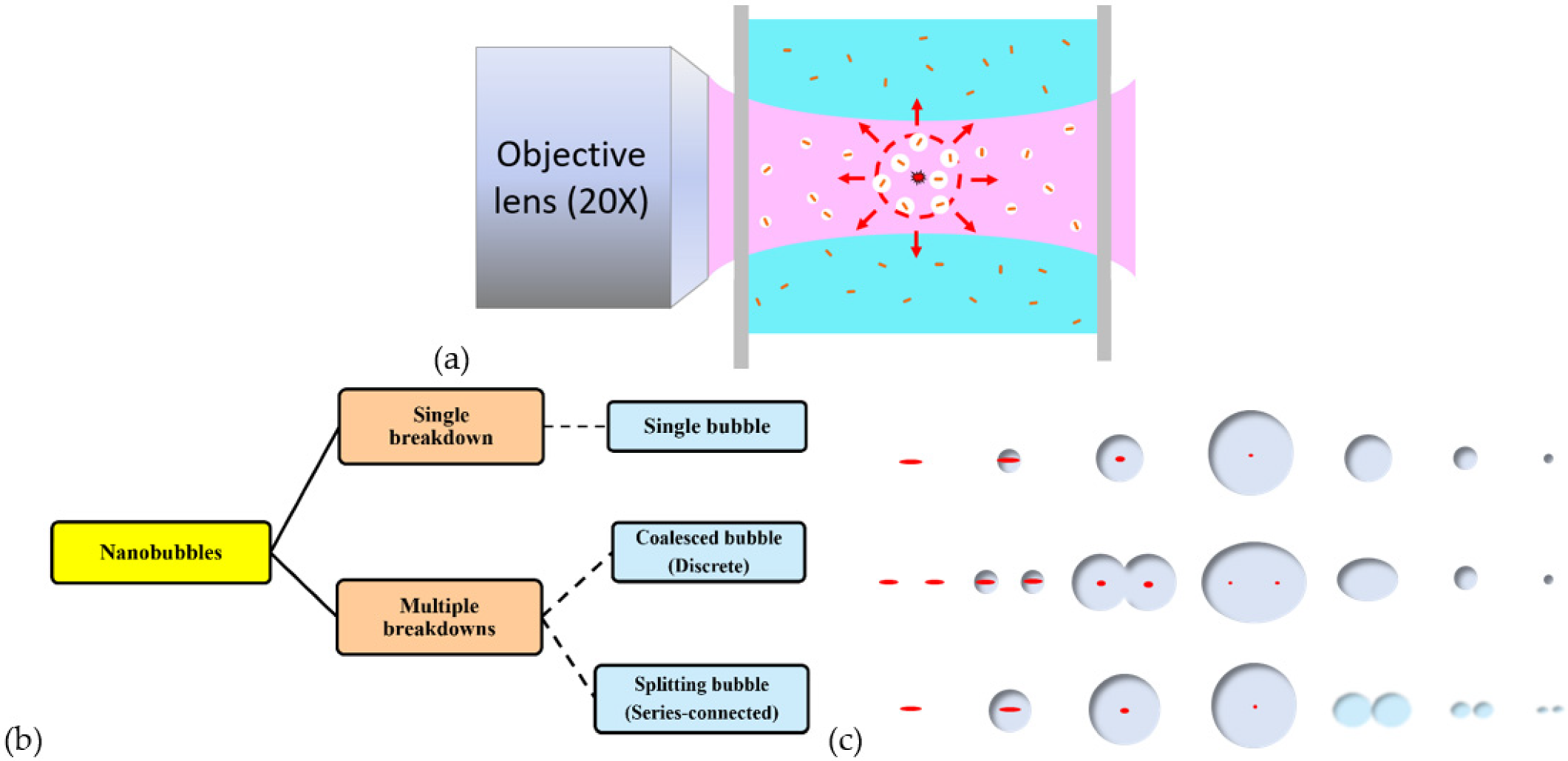
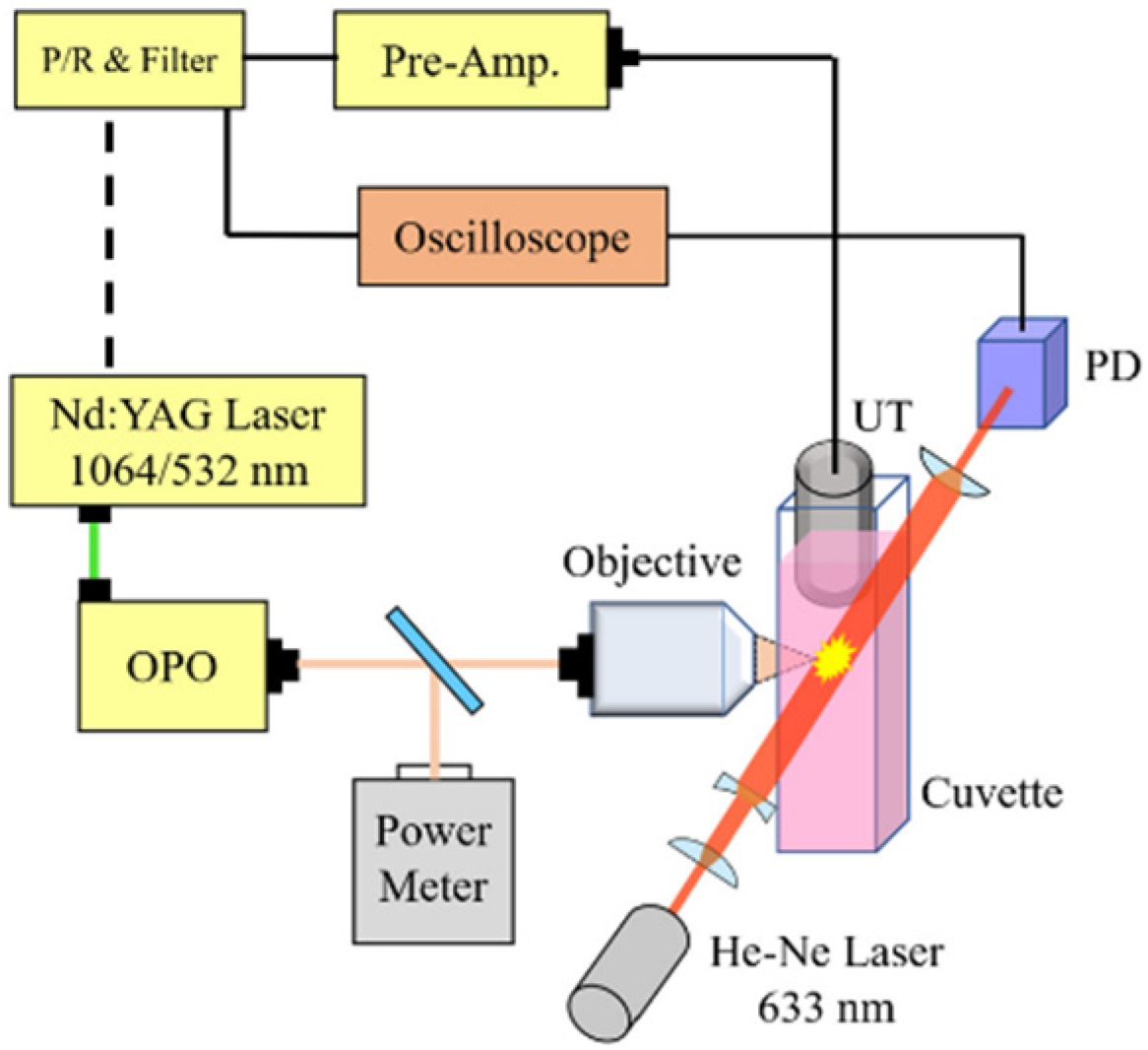
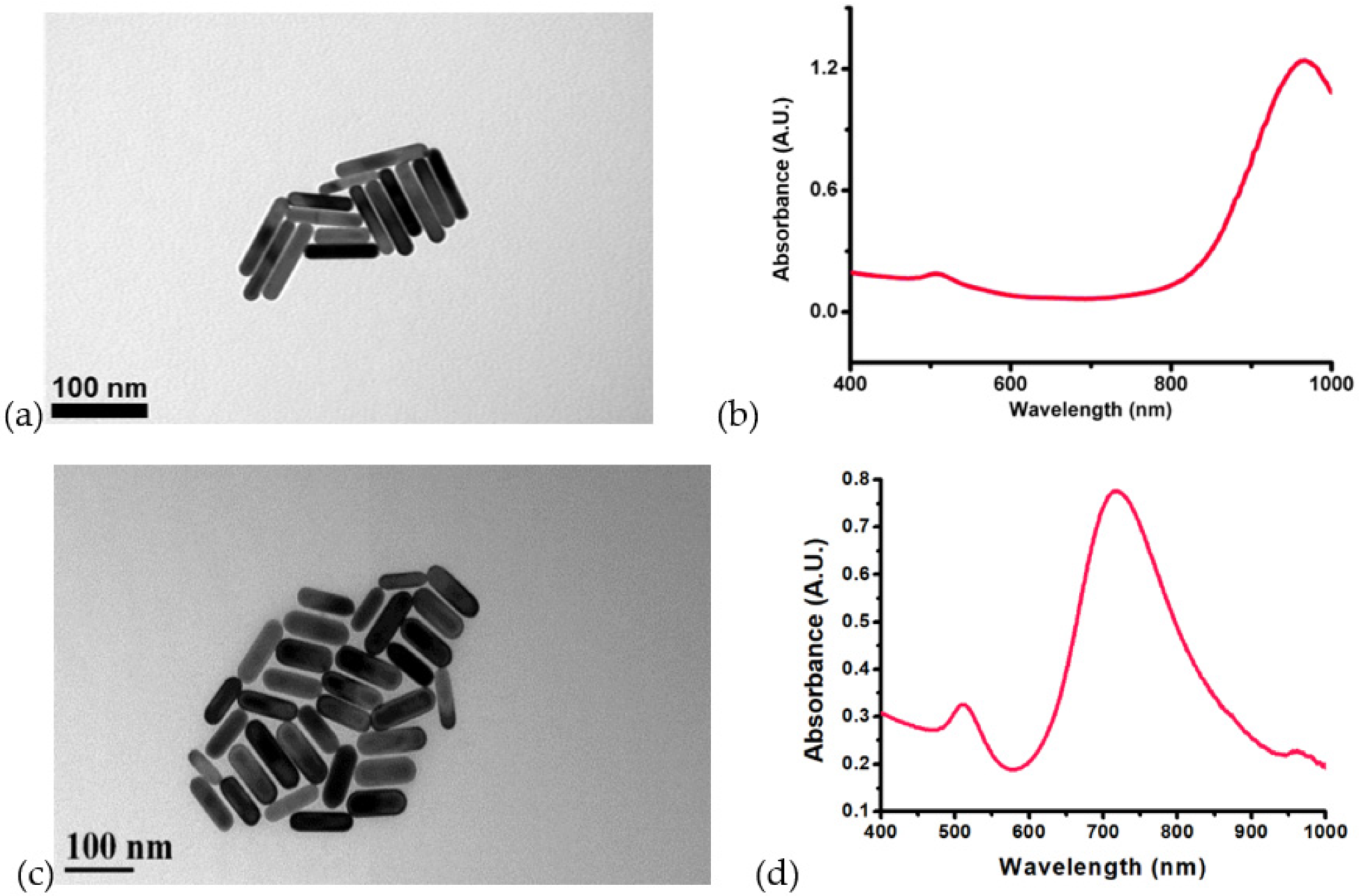
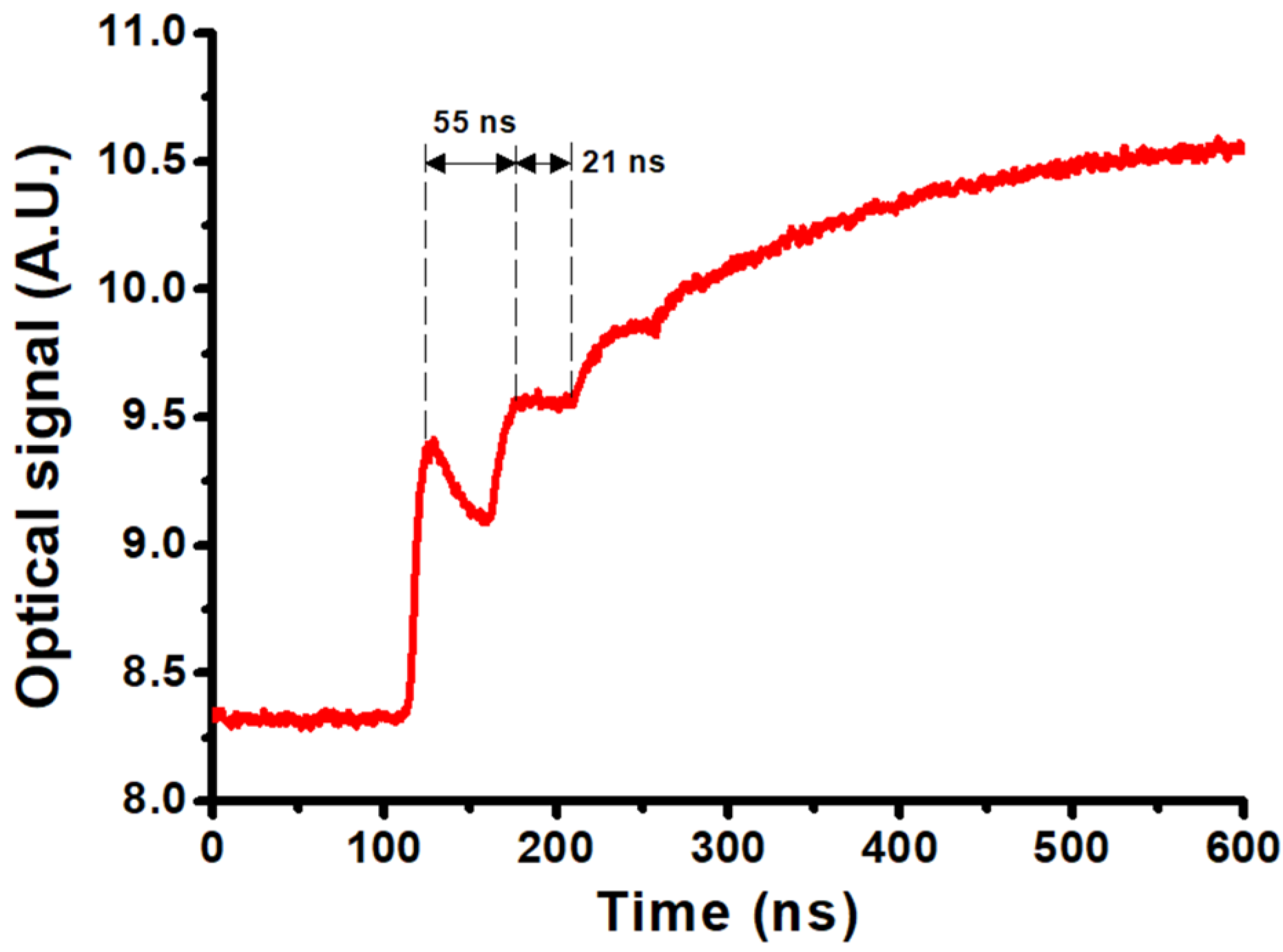



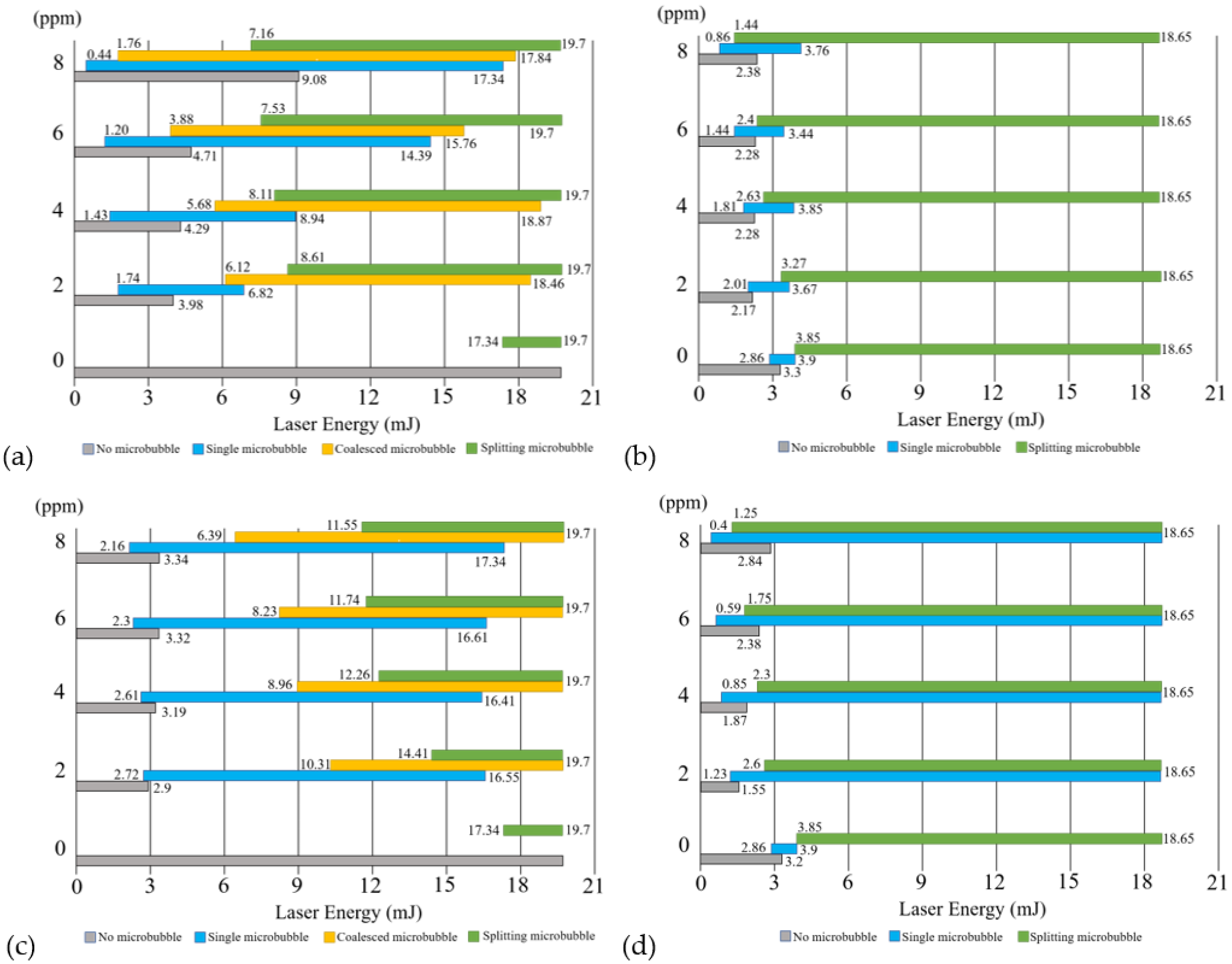
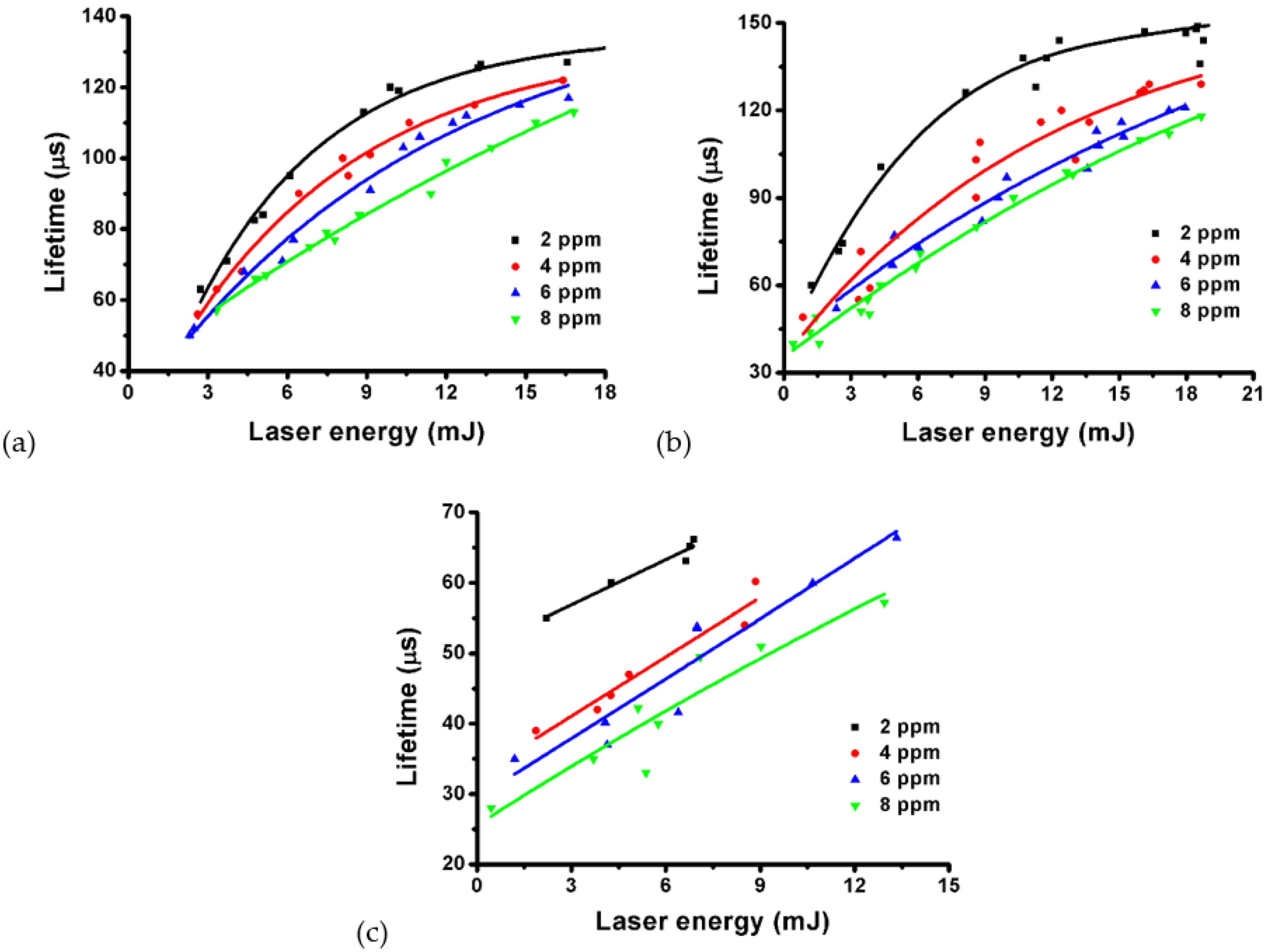
Publisher’s Note: MDPI stays neutral with regard to jurisdictional claims in published maps and institutional affiliations. |
© 2022 by the authors. Licensee MDPI, Basel, Switzerland. This article is an open access article distributed under the terms and conditions of the Creative Commons Attribution (CC BY) license (https://creativecommons.org/licenses/by/4.0/).
Share and Cite
Yu, S.-Y.; Tu, C.-H.; Liaw, J.-W.; Kuo, M.-K. Laser-Induced Plasmonic Nanobubbles and Microbubbles in Gold Nanorod Colloidal Solution. Nanomaterials 2022, 12, 1154. https://doi.org/10.3390/nano12071154
Yu S-Y, Tu C-H, Liaw J-W, Kuo M-K. Laser-Induced Plasmonic Nanobubbles and Microbubbles in Gold Nanorod Colloidal Solution. Nanomaterials. 2022; 12(7):1154. https://doi.org/10.3390/nano12071154
Chicago/Turabian StyleYu, Shang-Yang, Chang-Hsuan Tu, Jiunn-Woei Liaw, and Mao-Kuen Kuo. 2022. "Laser-Induced Plasmonic Nanobubbles and Microbubbles in Gold Nanorod Colloidal Solution" Nanomaterials 12, no. 7: 1154. https://doi.org/10.3390/nano12071154
APA StyleYu, S.-Y., Tu, C.-H., Liaw, J.-W., & Kuo, M.-K. (2022). Laser-Induced Plasmonic Nanobubbles and Microbubbles in Gold Nanorod Colloidal Solution. Nanomaterials, 12(7), 1154. https://doi.org/10.3390/nano12071154






